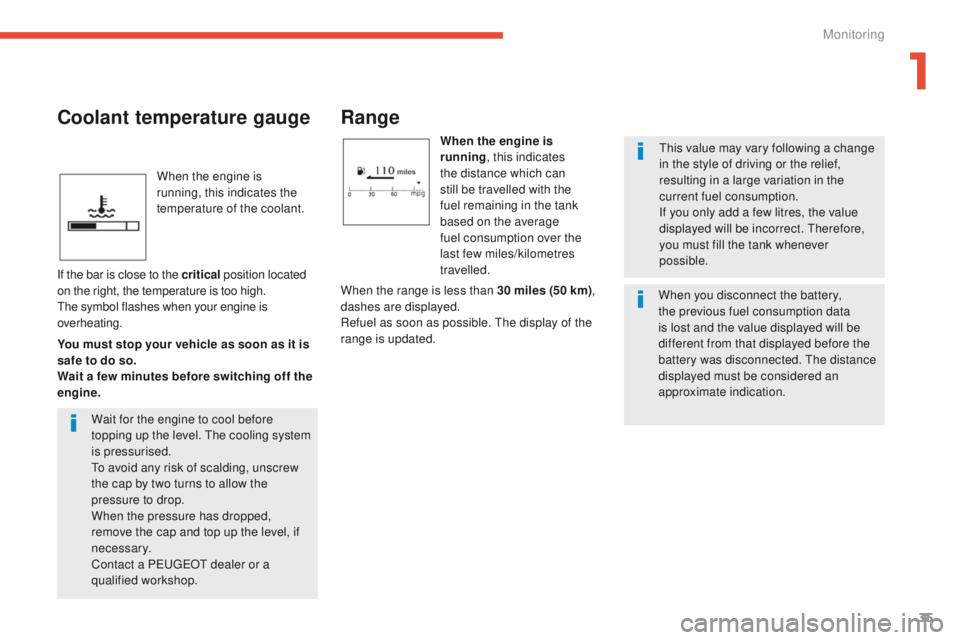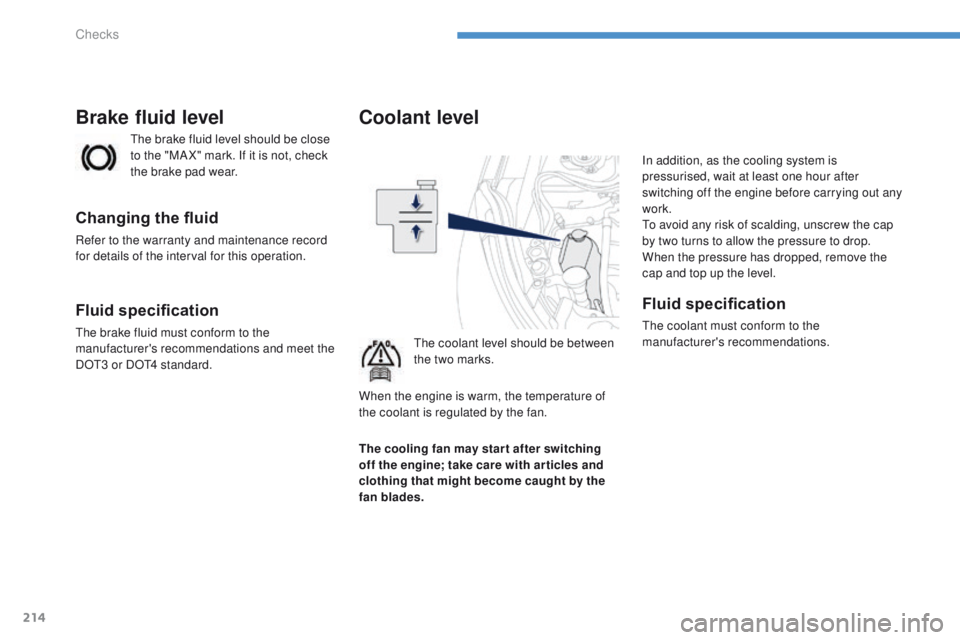Page 37 of 389

35
4008_en_Chap01_controle-de-marche_ed01-2014
When the engine is
running, this indicates the
temperature of the coolant.
Range
When the engine is
running, this indicates
the distance which can
still be travelled with the
fuel remaining in the tank
based on the average
fuel consumption over the
last few miles/kilometres
travelled.th is value may vary following a change
in the style of driving or the relief,
resulting in a large variation in the
current fuel consumption.
If you only add a few litres, the value
displayed will be incorrect.
t
h
erefore,
you must fill the tank whenever
possible.
Coolant temperature gauge
If the bar is close to the critical position located
on the right, the temperature is too high.
the
symbol flashes when your engine is
overheating.
You must stop your vehicle as soon as it is
safe to do so.
Wait a few minutes before switching off the
engine. When the range is less than 30 miles (50 km)
,
dashes are displayed.
Refuel as soon as possible.
t
h
e display of the
range is updated.
Wait for the engine to cool before
topping up the level. th e cooling system
is pressurised.
to a
void any risk of scalding, unscrew
the cap by two turns to allow the
pressure to drop.
When the pressure has dropped,
remove the cap and top up the level, if
necessary.
Contact a P
e
uge
Ot
dealer or a
qualified workshop. When you disconnect the battery,
the previous fuel consumption data
is lost and the value displayed will be
different from that displayed before the
battery was disconnected.
t
h
e distance
displayed must be considered an
approximate indication.
1
Monitoring
Page 204 of 389

202
4008_en_Chap07_info-pratiques_ed01-2014
Driving advice
Distribution of loads
F Distribute the load in the trailer so that the heaviest items are as close as possible to
the axle and the nose weight approaches
the maximum permitted without
exceeding
it.
Air density decreases with altitude, thus
reducing engine performance. Above
1
000 metres, the maximum towing load must
be reduced by 10
% of the gt
W a
nd so on for
every 1
000 metres of altitude.
Refer to the "
te
chnical Data" section for details
of the weights and towing loads which apply to
your vehicle.
Side wind
F take into account the increased sensitivity to side wind.
Cooling
towing a trailer on a slope increases the
temperature of the coolant.
As the fan is electrically controlled, its cooling
capacity is not dependent on the engine speed.
F
t
o l
ower the engine speed, reduce your
speed.
th
e maximum towing load on a long slope
depends on the gradient and the outside
temperature.
In all cases, pay attention to the coolant
temperature.
F
I
f this message is displayed, stop your
vehicle as soon as it is safe to do so.
Braking
towing a trailer increases the braking distance.
Ty r e s
F Check the tyre pressures of the towing vehicle and of the trailer, observing the
recommended pressures.
Lighting
F Check the lighting and signalling on the t r a i l e r.
If the message flashes slowly, wait for the
engine to cool before topping up the level,
if
necessary.
If the message flashes rapidly, contact a
P
e
uge
Ot
dealer or a qualified workshop
without delay.
Practical information
Page 216 of 389

214
4008_en_Chap08_verifications_ed01-2014
Coolant level
the coolant level should be between
the two marks.In addition, as the cooling system is
pressurised, wait at least one hour after
switching off the engine before carrying out any
work.
to a
void any risk of scalding, unscrew the cap
by two turns to allow the pressure to drop.
When the pressure has dropped, remove the
cap and top up the level.
Fluid specification
the coolant must conform to the
manufacturer's recommendations.
th
e brake fluid level should be close
to the "MA X" mark. If it is not, check
the brake pad wear.
Brake fluid level
Changing the fluid
Refer to the warranty and maintenance record
for details of the interval for this operation.
Fluid specification
the brake fluid must conform to the
manufacturer's recommendations and meet the
DO
t3 o
r DO
t4 s
tandard.
The cooling fan may star t after switching
off the engine; take care with ar ticles and
clothing that might become caught by the
fan blades. When the engine is warm, the temperature of
the coolant is regulated by the fan.
Checks